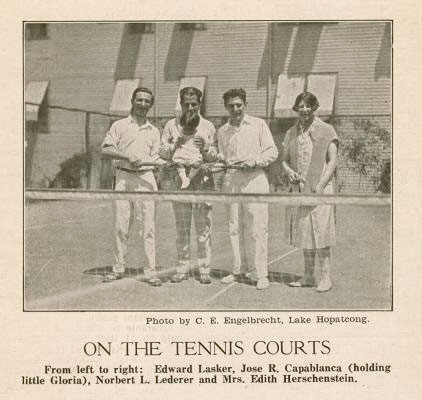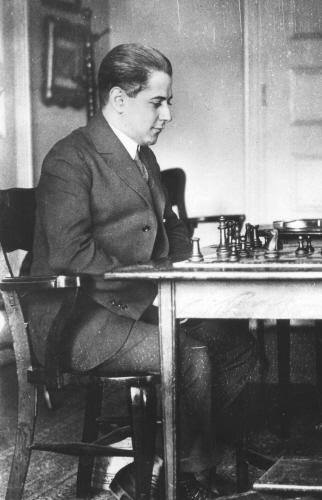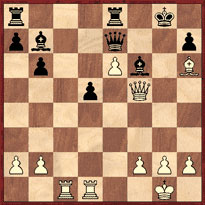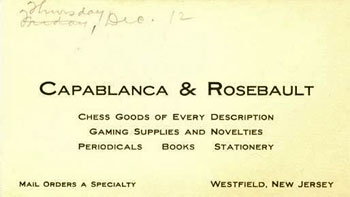Unsolved Chess Mysteries (12)
By Edward Winter
José Raúl Capablanca. In C.N. 3447 Brad Dassat (Oldham, England) suggested that the board position was from Hromádka v Spielmann, Pistyan, 1912, at White’s 18th move.
Capablanca v Teichmann
Virtually all of Capablanca’s serious (i.e. tournament and match) games are extant, a rare exception being his draw against Richard Teichmann at San Sebastián on 14 March 1911. Although it lasted about 20 moves, only the first eight are known. Below is the surviving portion, from page 147 of Le Tournoi d’Échecs de Saint-Sébastien by Henri Delaire (Paris, 1911):
The text by J.M. (Jacques Mieses) states that the game-score was mislaid. Even so, it is surprising that no complete record of the game from this major tournament has ever come to light.
‘The Chess Machine’
C.N. 4101 asked when Capablanca first acquired the nickname ‘The Chess Machine’. The earliest reference we have found so far is on page 98 of the May-June 1921 American Chess Bulletin:
‘Capablanca is a veritable chess machine, if ever there was one. Ajeeb, were he in power today, would have to take a back seat, and way back, too. Only a machine could have done with Lasker what the Cuban did at Havana ...’
Capablanca and Botvinnik
 Click to enlarge
Click to enlarge
C.N. 4919 presented the above photograph. Capablanca and Botvinnik are immediately recognizable, but is it possible to identify all the other persons?
Brilliancy against whom?
‘A really brilliant victory, especially when it is considered that Capablanca was playing 32 other players at the same time.’
So wrote D. Hooper and D. Brandreth on pages 152-153 of The Unknown Capablanca (London, 1975) when giving the following game, taken from Chess News, 1916, page 44:
José Raúl Capablanca – N.N.
New York, 11 January 1916
Queen’s Gambit Declined
1 d4 d5 2 Nf3 Nf6 3 c4 e6 4 Nc3 Bd6 5 Bg5 c6 6 e3 0-0 7 Rc1 dxc4 8 Bxc4 Nbd7 9 Bd3 Be7 10 0-0 b6 11 Qc2 Bb7 12 Ne5 g6 13 Bh6 Re8 14 Rfd1 Nxe5 15 dxe5 Nd5 16 Nxd5 exd5 17 e6 f5 18 Bxf5 gxf5 19 Qxf5 Bf6 20 e4 Qe7 21 exd5 cxd5
22 Rc7 Qxc7 23 Qxf6 Qe7 24 Qe5 Rf8 25 Rd3 Qf6 26 Rg3+ Kh8 27 Bg7+ Resigns.
C.N. 3488 asked whether scrutiny of the New York press of the time would allow Black to be identified.
A thousand rook and pawn endings
Many books state that Capablanca studied a thousand rook and pawn endings. C.N. 4068 commented that the meaning of this in concrete terms is unclear, and asked about the source of the story.
Chess Features
As mentioned in C.N.s 2849 and 3560, our collection contains two sheets of stationery with Capablanca indicated as the editor of Chess Features, but we lack information about the context (including, even, the exact period).
 Click to enlarge
Click to enlarge
Is the name Robert Mayer a clue? We wonder too whether the initiative is linked to a chess news service involving Capablanca referred to in C.N. 4198, which quoted from page 3 of the April 1933 issue of The Chess Reporter:
‘To the historic roster of eminent Masters taking up residence in good old USA must now be added the name of Capablanca.
He told us about it on the 15-mile drive that brought him into Los Angeles the first of the month, following his arrival by SS California from Panama and Cuba. “I am going to live in North America, probably New York City”, said Capablanca. “Among other plans I have incorporated a Chess News Service to furnish syndicate and special service to journals everywhere.”’
Capablanca v Réti, 1911
C.N. 1211 recalled a report on pages 175-176 of the Wiener Schachzeitung, May-June 1912 about a simultaneous exhibition by Capablanca in Vienna on 21 October 1911, his score being +22 –5 =8. One of the draws was secured by Richard Réti, but the game-score has not been traced.

José Raúl Capablanca
An anecdote
If chess literature is to feature anecdotes, let them at least have a point. One story, set during the London, 1922 tournament, which has some purpose was related by David Hooper in the Capablanca entry of Anne Sunnucks’ Encyclopaedia of Chess (London, 1970):
‘These two rivals [Capablanca and Alekhine] were taken to a variety show by a patron, Mr Ogle, who recalled that Capablanca never took his eyes off the chorus, whilst Alekhine never looked up from his pocket chess set.’
Referring to this in C.N. 3083, we added that in the first edition of The Oxford Companion to Chess (the Alekhine entry) the patron was named in full as Christopher Ogle, and that in at least one other modern outlet he has been described as a ‘chess patron’. That remains to be demonstrated, but our particular interest is in knowing the source of the Ogle/ogling recollection and whether there are further reminiscences from London, 1922.
Capablanca and Rosebault
A number of C.N. items have discussed the complex story of F.D. Rosebault, who for a time was Capablanca’s associate, as shown by the business card below:
The items have been brought together as a feature article, The Mysterious Frederick D. Rosebault.
Capablanca on the Sicilian Defence
R.N. Coles wrote on page 137 of Dynamic Chess (London, 1956) that Capablanca gave as his reason for practically never playing the Sicilian Defence, ‘Black’s game is full of holes’. The passage is on page 135 of the Dover edition (New York, 1966). As mentioned in C.N.s 2105 and 3961, we have been unable to locate a primary source for this quote.
Another alleged remark on which information has been requested, in C.N. 3961, appeared in a tribute to Capablanca by Reuben Fine on page 3 of The Chess Correspondent, May-June 1942:
‘Capa was a perfect example of the intuitive type of master, who sees that a move is good, but cannot explain why. I recall a story told me by a strong amateur in Mexico, whom Capa once offered to teach. The gentleman was overjoyed and promptly appeared the next day for his lesson. “In the Sicilian Defense”, Capa explained, “after 1 e4 c5 the best move is 2 Ne2.” “Why?” “No importa, it does not matter; it is the best move.” And that was about all that the poor amateur could find out; it was the best move and that was all there was to it. Capa’s judgement was usually right, so this absolute certainty in himself was an invaluable asset.’
Dressed for tennis
 From page 34 of the Lake Hopatcong, 1926 tournament book
From page 34 of the Lake Hopatcong, 1926 tournament book
What is the earliest known sighting of the well-known story about Capablanca turning up in his tennis gear to resume a game of chess against Yates at Hastings? See, for instance, pages 16-17 of The Bright Side of Chess by I. Chernev (Philadelphia, 1948).
C.N. 4114 opened the bidding with the following ‘once’ version by G. Koltanowski on page 180 of CHESS, 14 January 1936:
‘Capablanca once turned up to play off an adjourned game against Yates, dressed in white flannels and with a tennis racquet in his hand. Didn’t we chuckle when, four hours later, with the darkness of night outside the congress room, he was still playing – chess, not tennis.’
Koltanowski wrote similarly on page 80 of With the Chess Masters (San Francisco, 1972), but on page 24 of Chessnicdotes II (Coraopolis, 1981) he underscored once again his worthlessness as a chronicler by stating that the episode had occurred ‘in the 1929 tournament at Hastings’ in a game between Capablanca and Vera Menchik.
Marshall v Capablanca (living chess)
C.N. 4092 quoted from page 102 of the May-June 1929 American Chess Bulletin:
‘A “living chess” display was given in the Great Hall of the Regentenbau on 19 August [1928]. It was said to be the best ever given. Kissingen made it practically a city function. The “pieces” wore old Bavarian costumes, and their movements were directed by the court jester. The chess side of it was naturally arranged for spectacular purposes. Dr S. Tarrasch played a “skittle” game against E.D. Bogoljubow, and then J.R. Capablanca took the black forces against F.J. Marshall, this game ending in a draw by perpetual check, the white queen making the necessary moves to that end.’
Can the moves of the Marshall v Capablanca game be found in the local press?

José Raúl Capablanca
Submit information or suggestions on chess mysteries
 aficionados to discuss all matters relating to the Royal Pastime". Since then around 5,000 items have been published, and the series has resulted in four books by Winter: Chess Explorations (1996), Kings, Commoners and Knaves (1999), A Chess Omnibus (2003) and Chess Facts and Fables (2006). He is also the author of a monograph on Capablanca (1989).
aficionados to discuss all matters relating to the Royal Pastime". Since then around 5,000 items have been published, and the series has resulted in four books by Winter: Chess Explorations (1996), Kings, Commoners and Knaves (1999), A Chess Omnibus (2003) and Chess Facts and Fables (2006). He is also the author of a monograph on Capablanca (1989).
Chess Notes is well known for its historical research, and anyone browsing in its archives will find a wealth of unknown games, accounts of historical mysteries, quotes and quips, and other material of every kind imaginable. Correspondents from around the world contribute items, and they include not only "ordinary readers" but also some eminent historians – and, indeed, some eminent masters. Chess Notes is located at the Chess History Center.
Articles by Edward Winter
-
Edward Winter presents: Unsolved Chess Mysteries (1)
14.02.2007 – Since Chess Notes began, over 25 years ago, hundreds of mysteries and puzzles have been discussed, with many of them being settled satisfactorily, often thanks to readers. Some matters, though, have remained stubbornly unsolvable – at least so far – and a selection of these is presented here. Readers are invited to join in the hunt for clues.
-
Edward Winter presents: Unsolved Chess Mysteries (2)
12.03.2007 – We bring you a further selection of intriguing chess mysteries from Chess Notes, including the origins of the Marshall Gambit, a game ascribed to both Steinitz and Pillsbury and the bizarre affair of an alleged blunder by Capablanca in Chess Fundamentals. Once again our readers are invited to join the hunt for clues.
-
Edward Winter presents: Unsolved Chess Mysteries (3)
27.03.2007 – Recently-discovered photographs from one of Alekhine’s last tournaments, in Spain in 1945, are proving baffling. Do they show that a 15-move brilliancy commonly attributed to Alekhine is spurious? And do they disprove claims that another of his opponents was an 11-year-old boy? Chess Notes investigates, and once again our readers are invited to join in the hunt for clues.
-
Edward Winter presents: Unsolved Chess Mysteries (4)
10.04.2007 – What would have happened if the score of the 1927 Capablanca v Alekhine match had reached 5-5? Would the contest have been declared drawn? The affair has been examined in depth in Chess Notes. Here chess historian Edward Winter sifts and summarizes the key evidence. There is also the strange case of a fake photograph of the two masters. Join the investigation.
-
Edward Winter presents: Unsolved Chess Mysteries (5)
30.04.2007 – We bring you a further selection of mysteries from Edward Winter’s Chess Notes, including an alleged game by Stalin, some unexplained words attributed to Morphy, a chess magazine of which no copy can be found, a US champion whose complete name is uncertain, and another champion who has vanished without trace. Our readers are invited to join in the hunt for clues.
-
Edward Winter presents: Unsolved Chess Mysteries (6)
19.05.2007 – A further miscellany of mysteries from Chess Notes is presented by the chess historian Edward Winter. They include an alleged tournament game in which Black was mated at move three, the unclear circumstances of a master’s suicide, a chess figure who was apparently unaware of his year of birth, the book allegedly found beside Alekhine’s body in 1946, and the chess notes of the poet Rupert Brooke. Join in the hunt for clues.
-
Edward Winter presents: Unsolved Chess Mysteries (7)
02.06.2007 – The chess historian Edward Winter presents another selection of mysteries from Chess Notes. They include an alleged game by Albert Einstein, the origin of the Trompowsky Opening, the termination of the 1984-85 world championship match, and the Marshall brilliancy which supposedly prompted a shower of gold coins. Readers are invited to join in the hunt for clues.
-
Edward Winter presents: Unsolved Chess Mysteries (8)
In this further selection from Chess Notes historian Edward Winter examines some unauthenticated quotes, the Breyer Defence to the Ruy López, the origins of the Dragon Variation, the contradictory evidence about a nineteenth century brilliancy, and the alleged 1,000-board exhibition by an unknown player. Can our readers help to solve these new chess mysteries?
-
Edward Winter presents: Unsolved Chess Mysteries (9)
Why did Reuben Fine withdraw from the 1948 world championship? Did Capablanca lose an 11-move game to Mary Bain? Was Staunton criticized by Morphy for playing ‘some devilish bad games’? Did Alekhine play Najdorf blindfold? Was Tartakower a parachutist? These and other mysteries from Chess Notes are discussed by Edward Winter. Readers are invited to join in the hunt for clues.
-
Edward Winter presents: Unsolved Chess Mysteries (10)
15.07.2007 – Did Tsar Nicholas II award the ‘grandmaster’ title to the five finalists of St Petersburg, 1914? What connection exists between the Morphy family and Murphy beer? Can the full score of one of Pillsbury’s most famous brilliancies be found? Did a 1940s game repeat a position composed 1,000 years previously? Edward Winter, the Editor of Chess Notes, presents new mysteries for us to solve.
-
Edward Winter presents: Unsolved Chess Mysteries (11)
01.08.2007 – Did Alekhine attempt suicide in 1922? Why is 1 b4 often called the Hunt Opening? What are the origins of the chess proverb about the gnat and the elephant? Who was the unidentified figure wrongly labelled Capablanca by a chess magazine? Does Gone with the Wind include music composed by a chess theoretician? These and other mysteries from Chess Notes are discussed by the historian Edward Winter. Readers are invited to join the hunt for clues.
- Edward Winter presents: Unsolved Chess Mysteries (12)
12.08.2007 – This new selection from Chess Notes focuses on José Raúl Capablanca (1888-1942). The chess historian Edward Winter, who wrote a book about the Cuban genius in the 1980s (published by McFarland), discusses a miscellany of unresolved matters about him, including games, quotes, stories and photographs. Readers are invited to join in the hunt for clues.



























 aficionados to discuss all matters relating to the Royal Pastime". Since then around 5,000 items have been published, and the series has resulted in four books by Winter:
aficionados to discuss all matters relating to the Royal Pastime". Since then around 5,000 items have been published, and the series has resulted in four books by Winter: 




